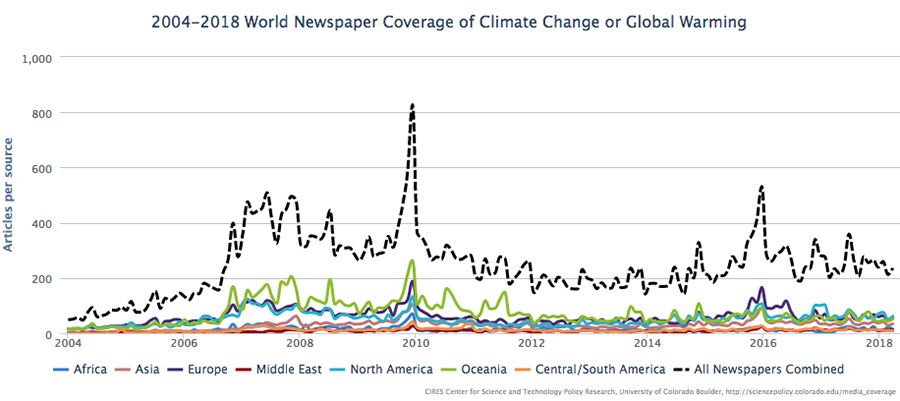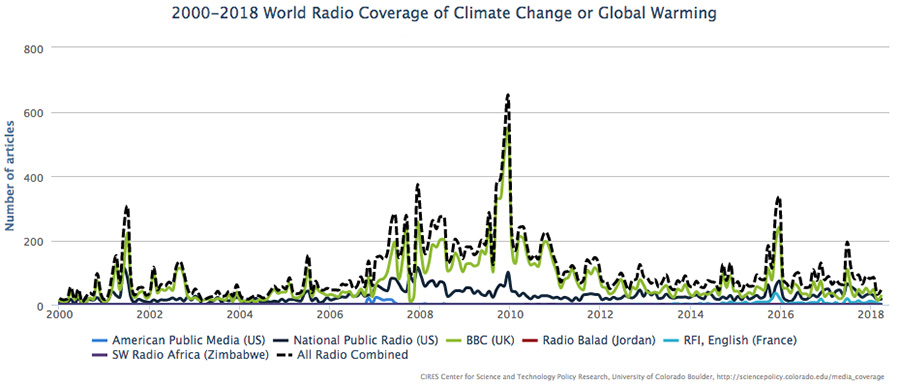Monthly Summaries
Issue 15, March 2018
[DOI]
March media attention to climate change and global warming was up 20% throughout the world from the previous month of February 2018. Coverage in Asia was up 44%, Europe increased 17%, Oceania went up 17%, and North America was up 23%. Central/South America dropped 10%, while coverage in Africa decreased 31%. In the Middle East, numbers remained relatively on par with February 2018 counts. Global numbers were about a third though of those (66% less) from counts a year ago (March 2017) when a great deal of global media attention was focused on US President Donald J. Trump’s plans to dismantle former US President Barack Obama’s Climate Action Plan along with high winter temperatures in northern locations like the Arctic circle.
Figure 1 shows these ebbs and flows in media coverage at the global scale - organized into seven geographical regions around the world - from January 2004 through March 2018.

Figure 1. Newspaper media coverage of climate change or global warming in sixty-two sources across thirty-five countries in seven different regions around the world, from January 2004 through March 2018.
At the country level in March 2018, coverage went down compared to February only in Germany (-29%). It was up in all other countries monitored: the United Kingdom (UK) (+17%), Canada (+7%), Australia (+4%), India (+59%), Spain (+26%), New Zealand (+42%) and the United States (+30%). Through MeCCO’s monitoring of six world radio sources (Figure 2), we can see that coverage has gone up from the previous month by 44%. Coverage in March 2018 compared to a year ago though (March 2017) was down 34%.

Figure 2. Radio coverage of climate change or global warming in 6 main sources: US American Public Media; US National Public Radio (National Public Radio-NPR, NPR All Things Considered, NPR Ask Me Another, NPR Code Switch, NPR Fresh Air, NPR Hidden Brain, NPR Morning Edition, NPR All Tech Considered/Parallels, NPR Planet Money, NPR TED Radio Hour, NPR Wait Wait Don't Tell Me!, NPR Weekend All Things Considered, NPR Weekend Edition Saturday, NPR Weekend Edition Sunday); UK BBC (IR, IR-Asian Pacific Stories, IR-European stories, IR-Middle East and Africa Stories, IR-North/South America Stories, IR-Top News Stories); Radio Balad (Jordan); RFI (France); and SW Radio Africa (Zimbabwe)
Moving to considerations of content of climate change or global warming coverage in March 2018, Figure 3 shows word frequency data at the country levels in global newspapers and radio, juxtaposed with US newspapers and US television in March 2018. It is notable that the US-based media sources showed continuing yet diminishing signs of ‘Trump Dump’ (where media attention that would have focused on other climate-related events and issues instead was placed on Trump-related actions (leaving many other stories untold)). And as in previous months, content in media reporting outside the US context shows that this pattern of news reporting continues to be limited to the US. To illustrate, March 2018 news articles related to climate change or global warming in the US invoked ‘Trump’ 2139 times through the 354 stories this month (a ratio of 6 times per article on average) in The Washington Post, The Wall Street Journal, The New York Times, USA Today, and the Los Angeles Times. In US television sources of ABC, CBS, CNN, Fox News Network, MSNBC, and NBC, Trump was mentioned 1873 times in 72 news segments (a whopping 26 mentions per segment). In contrast, in the UK press, Trump was mentioned in the Daily Mail & Mail on Sunday, Guardian & the Observer, the Sun, the Daily Telegraph & Sunday Telegraph, the Daily Mirror & Sunday Mirror, the Scotsman & Scotland on Sunday, and the Times & Sunday Times 595 times in 522 March articles (approximately 1.1 mentions per article on average).
As has been noted in previous MeCCO summaries, however, these current trends can quickly change if the Trump Administration again focuses attention on climate change or global warming in the months to come.

Figure 3. Word clouds showing frequency of words (4 letters or more) invoked in media coverage of climate change or global warming in global radio (left), along with US newspapers (center), and US television (right) in March 2018.
Many media accounts in March focused on primarily political content associated with climate change and global warming. For example, at the start of March, it was revealed through leaked emails to The New York Times that the location and accessibility of oil and natural gas drove decision-making by the Trump Administration to open up Bears Ears National Monument in southeastern Utah. In email exchanges with the US Department of Energy, top US elected officials like Utah Republican Senator Orrin Hatch is credited with pushing for the shrinking of the protected space by 85% in order to help resolve commercial mineral rights disputes (specifically coal deposits in the Kaiparowits plateau). As another example, journalists William Boston and Max Bernhard from The Wall Street Journal reported that the German automakers Volkswagen (who had been previously found guilty in an emissions test cheating scandal) announced plans to produce up to 3 million electric vehicles each year through 2025. And in later March, journalist Chris Mooney from The Washington Post ran one of many stories in media outlets around the globe of a conscious re-coupling of carbon dioxide (CO2) emissions and GDP. Departing from a trend in the last three years of flat CO2 emissions amid growing economies, a released International Energy Agency report announced a 1.4% CO2 increase in 2017, saying “if the world wants to cut emissions quickly and meet climate goals laid out in the Paris climate agreement, clean energy needs to grow about five times faster each year between now and 2040” As a final example of political content in March, the Financial Times reported on new plans afoot in Saudi Arabia (by a Japanese investment company called SoftBank) to build what would become the world’s largest solar-power-generation-project, bringing along approximately 100,000 clean energy jobs to the Middle East.
Meanwhile in March, coverage relating primarily to the cultural dimensions continued to draw attention. To illustrate, journalist Fiona Harvey wrote in The Guardian about a new World Bank report that forecasts as many as 143 million displaced people by 2050 (mainly from South Asia, Latin America and Sub-Saharan Africa) due to the impacts of climate change. On the consumption side of the equation, journalist Zlati Meyer from USA Today reported on a mid-March announcement from global food chain McDonald’s that they would be cutting their CO2 emissions from their supply chain (e.g. beef production practices) by approximately 31% by 2030.
Media stories also intersected with ecological and meteorological issues across the globe in March 2018. For example, the multiple winter storms that hit the Northeastern US (called ‘Nor’easters’) garnered media attention. For example, Christopher Joyce from US National Public Radio reported on flooding dimensions of these storms becoming a new normal in future years, according to research from the National Oceanic and Atmospheric Administration (NOAA). Joyce quoted NOAA’s Dr. William Sweet who said, “The numbers are staggering... The problem is going to become chronic rather quickly. It's not going to be a slow, gradual change".
Attention was also paid to scientific dimensions of climate change and global warming. For instance, journalist Jonathan Watts from The Guardian covered a new report from the United Nations-sponsored Intergovernmental Science-Policy Platform on Biodiversity and Ecosystem Services. It stated that the world's biodiversity has been shrinking at an alarming rate, and human activities like climate change are responsible. The report outlined stark predictions such as Africa losing half of bird and mammal species by 2100, Asia losing all of its commercial fishing by mid-century, and a 15% reduction in plant and animal species in the Americas by 2050. Also, journalists Kendra Pierre-Louis, Nadja Popvich and Adam Piece at The New York Times reported on satellite measurements from the National Snow and Ice Data Center (NSIDC) (a center within the Cooperative Institute for Research in Environmental Sciences where MeCCO is also housed) showed the second-lowest annual Arctic ice cover maximum ever recorded. NSIDC Director Mark Serreze lamented, “it’s a case where we hate to say we told you so, but we told you so…we’ve probably known for 100 years that as the climate warms up in response to loading the atmosphere with greenhouse gases, we would see the changes first in the Arctic”.
As spring melt leads into summer heat in 2018, MeCCO will continue to track the ebbs and flows of climate change or global warming coverage in 74 media sources (newspapers, radio and TV) in 38 countries in seven different regions around the world.
